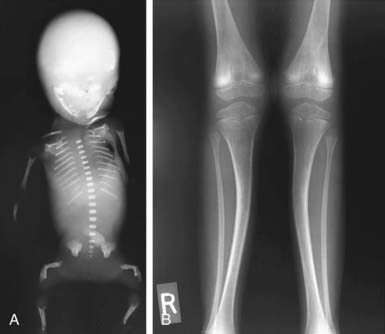Chapter 696 Hypophosphatasia
There is considerable heterogeneity in the severity of the disease. Some cases appear at birth, and diagnosis has even been made in utero by radiographic examination of a fetus. The disease can appear in a lethal neonatal or perinatal form (congenital lethal hypophosphatasia), a severe infantile form, or a milder form occurring in childhood or late adolescence (hypophosphatasia tarda) (Fig. 696-1). The lethal form is characterized by a moth-eaten appearance at the ends of the long bones, severe deficiency of ossification throughout the skeleton, and marked shortening of the long bones. Patients with mild disease can present with bowing of the legs and variable statural shortening. Hypercalcemia is common in the neonatal and infantile forms, and because calcium accumulation by mature chondrocytes does not occur, patients might appear to have rickets.
Carpenter TO. Disorders of mineral metabolism in childhood. In: Rosen CJ, Compston JE, Lian JB, editors. Primer on the metabolic bone diseases and disorders of mineral metabolism. Washington, DC: American Society for Bone and Mineral Research; 2008:349-353.
Slovis TL, editor. Caffey’s pediatric diagnostic imaging, ed 11, vol 2. Philadelphia: Mosby, 2008.







